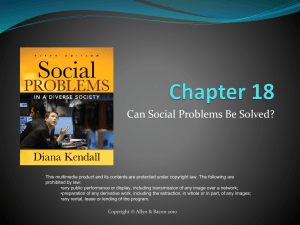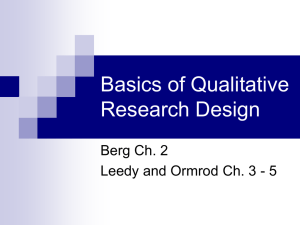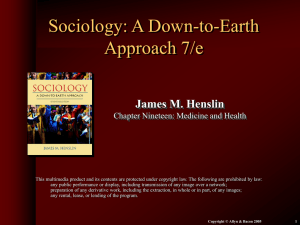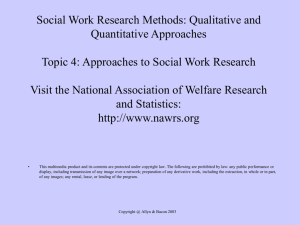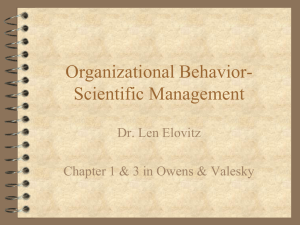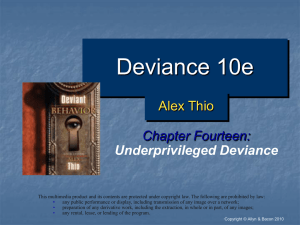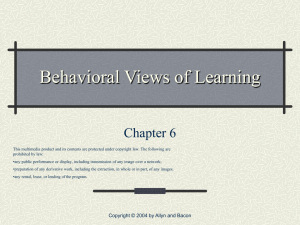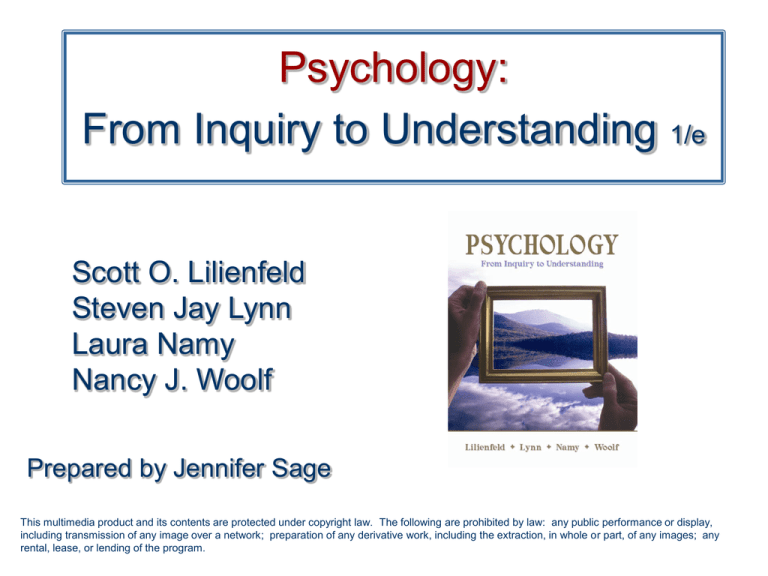
Psychology:
From Inquiry to Understanding 1/e
Scott O. Lilienfeld
Steven Jay Lynn
Laura Namy
Nancy J. Woolf
Prepared by Jennifer Sage
This multimedia product and its contents are protected under copyright law. The following are prohibited by law: any public performance or display,
including transmission of any image over a network; preparation of any derivative work, including the extraction, in whole or part, of any images; any
rental, lease, or lending of the program.
Chapter 16:
Psychological and Biological
Treatments
Helping People Change
Copyright © Allyn & Bacon 2009
Lecture Preview
Identify who seeks psychotherapy and who
benefits from it
Describe and evaluate the effectiveness of
insight therapies and behavioral therapies
Explore group and family therapies
Discuss whether psychotherapy is effective
Identify biological treatments for psychological
problems
Copyright © Allyn & Bacon 2009
Psychotherapy
Who goes to therapy?
Who practices therapy?
Women are more likely than men
Caucasian Americans are more likely than Asian
Americans and Hispanic Americans
Clinical psychologists, psychiatrists, mental health
counselors, clinical social workers,
paraprofessionals
Who benefits most from therapy?
Patients with some anxiety often do better
Patients who are better adjusted to begin with
Copyright © Allyn & Bacon 2009
Psychoanalysis: The First Therapy
Sigmund Freud – believed abnormal behavior
was caused by unconscious feelings, thus the goal
of psychotherapy was to make conscious these
unconscious feelings
Six primary approaches:
Free association – patients express themselves
without censorship
Interpretation – therapists formulate explanations
from the free association
Dream analysis – dreams express unconscious
feelings, the therapist can interpret these
Copyright © Allyn & Bacon 2009
Psychoanalysis: The First Therapy
Freud’s six primary approaches (cont.):
Resistance – attempts to avoid confrontation and
anxiety associated with uncovering previously
repressed thoughts, emotions, and impulses
Transference – projecting intense, unrealistic
feelings and expectations from the past onto the
therapist
Working through – confronting and resolving
problems, conflicts, and ineffective coping responses
in everyday life
Copyright © Allyn & Bacon 2009
Neo-Freudian Psychoanalysis
Followers of Freud consider conscious, cultural,
and interpersonal influences on behavior, along
with adopting a more positive approach.
Jung’s Analytic Psychology – focused on
individuation, the integration of opposing aspects of the
patients personality
Amplification – patients and therapists expand on
dream associations
Prognostic dreams – dreams that foretell the future
Copyright © Allyn & Bacon 2009
Neo-Freudian Psychoanalysis
Object relations therapists – emphasize
patients’ mental representations of
themselves and others
Focus on patients’ difficulties with trust,
attachment, separation, identity formation
Interpersonal therapy – short-term
treatment that strengthens socials skills and
targets interpersonal problems, conflicts, and
life transitions
Copyright © Allyn & Bacon 2009
Critical Analysis of Psychodynamic
Therapies
Many treatments are not scientifically sound:
Poor external validity – Freud and Jung had a limited
population of wealthy, intelligent, successful people
Clinical sessions were never systematically examined
and thus could not be replicated
Relied heavily on memories from the patient’s past,
yet recent evidence has called into question the
validity of these memories
Not falsifiable - unable to disprove rival hypotheses
Research has shown that brief treatments are better than
none, however, they do not work as well as other
therapies (e.g., cognitive behavioral therapy)
Copyright © Allyn & Bacon 2009
Apply Your Thinking
What were some of the consequences of
psychoanalytical methods that attempted
to bring out repressed memories?
There is little evidence for the existence of repressed
memories and the consequences can be far-reaching.
A number of patients have “remembered” past sexual
abuse and attributed them as the cause of their
problems, only to find out that these memories were not
real. This is dangerous, as it has sent a number of
people to jail, and it does not treat the actual cause of
the mental illness.
Copyright © Allyn & Bacon 2009
Humanistic-Existential
Psychotherapy
Therapies that share an emphasis on the
development of human potential and the belief
that human nature is basically good
Humanistic – self-actualization occurs naturally,
unless roadblocks hamper it
Existential – struggle, pain, and self-discipline
inevitably occur along the road to personal fulfillment
Both utilize a phenomenological approach –
therapists encounter patients in terms of the
subjective phenomena (thoughts, feelings) they
experience in the present
Copyright © Allyn & Bacon 2009
Humanistic-Existential
Psychotherapy
Person-centered therapy – centered on
the patient’s goals and ways of solving
problems
Carl Rogers
Therapists don’t tell the patient how to solve
their problems, and patients can use their
time however they choose
Therapists exhibit unconditional positive
regard to elicit a more positive self-concept
Copyright © Allyn & Bacon 2009
Humanistic-Existential
Psychotherapy
Gestalt therapy – aims to
integrate different, and
sometimes opposing
aspects of personality, into
a unified sense of self
Two-chair technique to
promote self-awareness
Considered an experiential
therapy because it
recognizes the importance of
awareness, acceptance, and
expression of feelings
Copyright © Allyn & Bacon 2009
Humanistic-Existential
Psychotherapy
Logotherapy – therapeutic approach that
helps people find meaning in their lives
Victor Frankl – believed that humans can
preserve freedom of mind through even the
worst conditions imaginable
Discourages patients from blaming past
circumstances, other people, and adverse
situations for their difficulties
Copyright © Allyn & Bacon 2009
Critical Evaluation of HumanisticExistential Therapies
Difficult to falsify
Like Roger suggested, therapeutic relationship does
appear to be a strong predictor of therapeutic
success
Empathy and positive regard are moderately
correlated to therapeutic success
However, most research comes from clinical
anecdotes and case studies
Ultimately, these therapies are generally
successful, however there is disagreement on
the level of success
Copyright © Allyn & Bacon 2009
Behavioral Approaches
Behavioral therapy – focuses on specific
problem behaviors, and current variables that
maintain problematic thoughts, feelings, and
behaviors
Seeks to identify and assess the problem, then design
and implement a strategy for behavior change
Exposure therapy – confronts patients with their
fears, with the goal of reducing that fear
Systematic desensitization – patients are taught to
relax as they are gradually exposed to what they fear,
in a stepwise manner
Flooding – patients immediately experience their
greatest fear, with no aversive consequences
Copyright © Allyn & Bacon 2009
Flooding
Based on the idea that fears are maintained by
avoidance (negative reinforcement)
Flooding provokes anxiety in the absence of
negative consequences, so that extinction can
proceed
Response prevention is critical - therapists prevent
patients from performing their typical avoidance
behaviors
Can be done with virtual reality
Copyright © Allyn & Bacon 2009
Dismantling Desensitization
Dismantling – research procedure for
examining the effectiveness of isolated
components of a larger treatment
Dismantling studies show that each
component of desensitization (relaxation,
imagery, anxiety hierarchy) can be
eliminated without affecting the treatment
Placebo effect or extinction of fear?
Copyright © Allyn & Bacon 2009
True or False?
Misuse of a flooding procedure can actually
lead to increased fear.
TRUE. If flooding is not done for long enough
there can be negative consequences. The
exposure to the fearful stimulus must be
sufficient, and without negative
consequences. Any negative reaction the
patient experiences may be enough to
worsen their fear.
Copyright © Allyn & Bacon 2009
Behavioral Approaches
Participant modeling – therapist first models a
problematic situation, and then guides the
patient through steps to cope with it unassisted
Important component of assertion training and
behavioral rehearsal
Operant procedures – using reward and
punishment to shape behavior
Token economy – desirable behaviors are
rewarded with tokens that patients can exchange for
tangible rewards
Aversion therapy – uses punishment to decrease
the frequency of undesirable behaviors
Copyright © Allyn & Bacon 2009
Behavioral Approaches
Cognitive-behavior therapy – attempts to replace
maladaptive or irrational cognitions with more adaptive,
rational ones
Core assumptions:
Cognitions can be identified and measured
Cognitions are the key player in both healthy and
unhealthy psychological functioning
Irrational beliefs can be replaced by more rational and
adaptive cognitions
At least as effective as psychodynamic, personcentered, or drug therapies
Can be effectively combined with drug therapies or
marital counseling
Copyright © Allyn & Bacon 2009
Group Therapies
About as effective as individual treatment for
most problems
Internet self-help groups have recently
surged and can be effective
Alcoholics Anonymous is a Twelve-Step,
self-help program that provides social
support for achieving sobriety
• Research indicates this program is about as
effective as cognitive-behavioral therapy, however
the sample may not be representative of the entire
alcoholic population, since 68% of participants
drop out within 3 months
Copyright © Allyn & Bacon 2009
Apply Your Thinking
How might high dropout rates distort the
findings of studies that examine the
success of AA?
Random selection is compromised when there is a high
dropout rate. People who drop out of AA may do so
because they are unsatisfied with the progress they are
making. The remaining 32% may be the ones that are
doing well in the program. However, they are not a
representative sample of the alcoholic population and
the results may have low external validity.
Copyright © Allyn & Bacon 2009
Family Therapy
Strategic family intervention – family therapy
approach designed to remove barriers to effective
communication
Structural family therapy – treatment in which
therapists deeply involve themselves in family activities
to change the structure of interactions
Copyright © Allyn & Bacon 2009
Is Psychotherapy Effective?
Dodo bird verdict – some researchers believe
that all treatments are equal and effective
May be due to common factors between therapies
Many others are not convinced
Behavioral and cognitive-behavior therapies are
often more effective in many domains
Some therapies can have negative effects:
• Facilitated communication, Scared Straight programs,
recovered-memory techniques, dissociative identity disorderoriented psychotherapy
Different groups may respond differently
Copyright © Allyn & Bacon 2009
Is Psychotherapy Effective?
Empirically supported therapies (ESTs) –
treatments for specific disorders supported by
high-quality scientific evidence
• Many therapies are not supported by empirical data
• A treatment that is not an EST does not mean it is not
effective, perhaps it has not been properly tested
• Supporters of ESTs argue that the best scientific evidence
should inform clinical practice
Copyright © Allyn & Bacon 2009
How Do Bogus Therapies
Fool Us?
Spontaneous remission - unrelated to the
therapy
The placebo effect
Self-serving biases - convince themselves
they’ve been helped, if the patient has invested
time and money
Regression to the mean - extreme scores
become less extreme on re-testing
Retrospective rewriting of the past adjusting pretreatment memories
Copyright © Allyn & Bacon 2009
Biological Treatments
Pharmacotherapy – use of medications
to treat psychological problems
Selective serotonin reuptake inhibitors
(SSRIs) are commonly prescribed to treat
depression
Drug companies claim these drugs fix a
“chemical imbalance” in the brain, but the
fact is that they likely work through complex
mechanisms yet to be discovered
Copyright © Allyn & Bacon 2009
Apply Your Thinking
What makes you happy? What factors other
than drugs, or psychotherapy might be effective
at treating mild depression?
Researchers have found that natural light makes
people happier. This is believed to be involved in
seasonal affective disorder, but can also be applied
to clinically depressed patients. Patients given light
therapy often respond as well as patients on antidepressant medications, and the effects are
immediate. The reason you like the summer so
much isn’t just because there’s no school!
Copyright © Allyn & Bacon 2009
Cautions about Pharmacotherapy
Side effects are usually reversible when the
drug is discontinued, but some are not
Tardive dyskinesia (TD) – irreversible side effect of
some antipsychotic drugs causing involuntary
movements of facial muscles and twitching of the
neck, arms, and legs
Different patients require different doses
Sex, ethnicity, body weight can alter response
Copyright © Allyn & Bacon 2009
Biological Treatments
Electroconvulsive therapy (ECT) – brief electrical
pulses to the brain which produce a seizure and treat
serious psychological problems (last resort)
Effective: 80-90% improvement rates
Not as uncomfortable as it sounds
• 98% of patients said they would have ECT again if their
depression returned
• Adverse side effects:
• Memory and attention problems can persist 6 months after
treatment
Vagus nerve stimulation – electrical pulses to treat
major depression
Large scale study has not been done
Copyright © Allyn & Bacon 2009
Psychosurgery
Psychosurgery – brain surgery to treat
psychological problems
1950s - researchers claimed that prefrontal
lobotomies were effective treatments for a
range of disorders
• Heavy criticism of this practice
• Surgeries became more targeted to decrease side
effects
• Today psychosurgery is used as an absolute last
resort
• Few well-controlled studies have been performed
Copyright © Allyn & Bacon 2009




